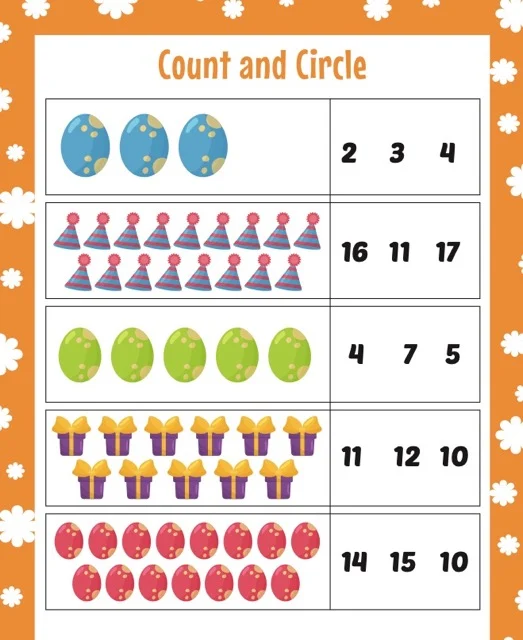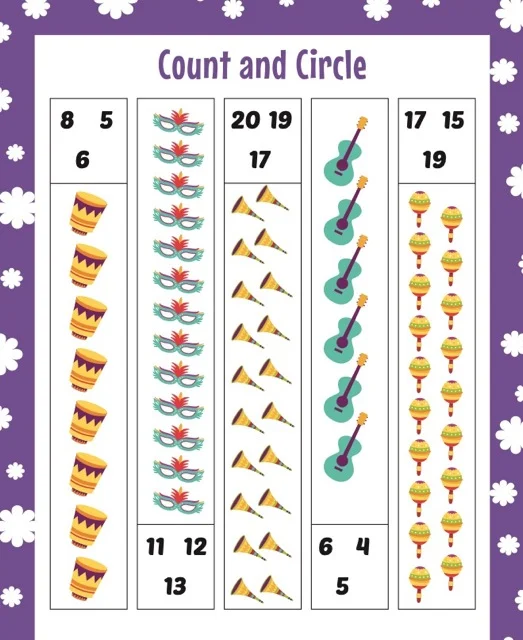Count and Circle: A Math Activity Guide
The provided texts detail the "Count and Circle" activity, an educational tool designed to teach young children basic math skills. The activity involves counting objects and circling the corresponding numeral, enhancing number recognition, one-to-one correspondence, and fine motor skills. Multiple variations are suggested, including using real objects and thematic groupings, to increase engagement and difficulty. The guides offer implementation strategies for educators and parents, emphasizing the activity's adaptability and benefits for cognitive development. Overall, the materials present a comprehensive guide for utilizing this simple yet effective learning tool.
Count and Circle Activity Guide
Count and Circle Activity FAQ
1. What is the "Count and Circle" activity?
This activity involves counting the number of specific objects within a given set and circling the correct number from a list of options.
2. What age group is this activity appropriate for?
The activity is designed for young learners in the early stages of developing their counting and number recognition skills. This could include preschool, kindergarten, and early elementary school students.
3. What skills does this activity help develop?
●
Counting skills: Children practice counting objects accurately.
●
Number recognition: They learn to identify and differentiate between written numerals.
●
One-to-one correspondence: They develop the understanding of associating one number with one object while counting.
●
Fine motor skills: Circling the correct number enhances their fine motor control.
4. What types of objects are used in the activity?
The activity features a variety of colorful and engaging objects to keep children interested. These include everyday items like fruits, toys, animals, and shapes.
5. How does the activity progress in difficulty?
The initial exercises start with smaller sets of objects and a limited number of answer choices. As children advance, the number of objects increases, and the range of answer choices expands, challenging their counting and number recognition abilities further.
6. Are there different variations of the activity?
Yes, the "Count and Circle" activity can be modified in several ways:
●
Using real objects: Instead of pictures, utilize physical objects for a more hands-on experience.
●
Creating themes: Group objects by themes like colors, shapes, or categories for an added learning dimension.
●
Introducing number words: Include written number words alongside numerals for a more comprehensive learning approach.
7. What are the benefits of using this activity?
●
Engaging and fun: The colorful visuals and diverse objects make learning enjoyable.
●
Reinforces basic math concepts: It solidifies foundational counting and number recognition skills.
●
Promotes independent learning: Children can work through the exercises at their own pace.
●
Versatile and adaptable: The activity can be tailored to different learning levels and preferences.
8. How can I incorporate this activity into learning at home?
●
Print out worksheets: Download and print the activity sheets provided or create your own.
●
Use everyday objects: Count toys, snacks, or items around the house and have your child circle the correct number written on a piece of paper.
●
Make it interactive: Turn it into a game by hiding objects and having your child count them as they find them.
Count and Circle Activity Guide
Count and Circle Activity Study Guide
Key Terms and Definitions
Count and Circle Activity: An educational activity for young learners that involves counting a set of objects and circling the correct numerical representation from a list of options.
One-to-one Correspondence: The fundamental math concept of pairing each object with one and only one number word or numeral while counting.
Number Recognition: The ability to identify and distinguish between different written numerals.
Fine Motor Skills: The coordination of small muscles, often involving hands and fingers, for precise movements such as writing, drawing, or circling.
Scaffolding: The educational approach of gradually increasing the complexity or difficulty of tasks to support learning and development.
Short Answer Quiz
1.
What is the primary goal of the Count and Circle activity?
2.
Describe the target age group for this activity and why it is appropriate for them.
3.
Explain the concept of one-to-one correspondence and its role in the Count and Circle activity.
4.
How does the Count and Circle activity contribute to the development of fine motor skills?
5.
List three benefits of incorporating the Count and Circle activity into early childhood education.
6.
How does the "Count and Circle Activity Guide" suggest the activity can be adjusted for increasing difficulty?
7.
Explain how using real objects instead of pictures can enhance the learning experience.
8.
Provide an example of how the Count and Circle activity can be integrated with a specific theme, such as colors or shapes.
9.
Suggest a method for incorporating number words into the activity for a more comprehensive understanding.
10.
Describe one way the Count and Circle activity can be adapted for use in a home learning environment.
Answer Key
1.
The primary goal of the Count and Circle activity is to develop and reinforce counting skills and number recognition in young learners.
2.
The target age group is preschool, kindergarten, and early elementary students. This activity is appropriate because it aligns with their developing cognitive abilities and introduces fundamental math concepts in an engaging manner.
3.
One-to-one correspondence means assigning one number word or numeral to each object while counting. This concept is crucial in the Count and Circle activity as children learn to accurately count objects and associate them with the correct numerical representation.
4.
The act of circling the correct number requires precise hand-eye coordination and control of small muscles in the hand and fingers, thus enhancing fine motor skills.
5.
Benefits of the Count and Circle activity include: (a) making learning enjoyable through colorful visuals and diverse objects; (b) strengthening basic math concepts like counting and number recognition; and (c) promoting independent learning by allowing children to work at their own pace.
6.
The guide suggests progressively increasing the number of objects to be counted and expanding the range of numerical answer choices. This gradual increase in complexity challenges children's counting and number recognition abilities.
7.
Using real objects provides a tactile and kinesthetic learning experience, allowing children to manipulate and interact with the objects directly. This hands-on approach can enhance engagement and deepen their understanding of counting.
8.
To incorporate the theme of colors, you could have a set of objects of various colors, such as red, blue, and green. The activity would then involve counting the objects of a specific color and circling the corresponding number.
9.
Number words can be introduced by including them alongside the numerals in the answer choices. For example, "3" could be written next to "three." This helps children connect the written numeral with its corresponding word, promoting a more holistic understanding of numbers.
10.
In a home setting, parents can use everyday objects like toys or snacks. They can lay out a specific number of items, write the possible numerical representations on paper, and have the child circle the correct answer after counting the objects.
Essay Questions
1.
Discuss the ways in which the Count and Circle activity contributes to the overall cognitive development of young children.
2.
Analyze the role of visual aids and engaging materials in enhancing the effectiveness of the Count and Circle activity.
3.
Evaluate the importance of scaffolding in the context of the Count and Circle activity and its impact on promoting successful learning outcomes.
4.
Explain how the Count and Circle activity can be adapted and differentiated to cater to the diverse learning needs and abilities of children.
5.
Compare and contrast the benefits of using physical manipulatives versus pictorial representations in the Count and Circle activity, considering factors such as engagement, understanding, and skill development.
Count and Circle Activity: A Guide for Educators
Count and Circle Activity: A Briefing Doc
This briefing document reviews the "Count and Circle" activity, summarizing key themes and important facts based on provided source materials: "Count and Circle Activity Guide" and "OMTEX CLASSES: Count and Circle.pdf".
What is the Count and Circle Activity?
The Count and Circle activity is a simple yet effective educational tool designed for young learners, typically in preschool, kindergarten, and early elementary school. The core of the activity involves:
1.
Counting: Children count a set of objects presented visually.
2.
Circling: From a list of numerical options, they then circle the number that corresponds to the counted set.
Educational Goals and Benefits:
●
Developing Foundational Math Skills: The primary goal is to reinforce early counting skills and solidify number recognition. This is achieved through the repeated practice of one-to-one correspondence, where children learn to associate each object with one specific number. As stated in the "Count and Circle Activity Guide," "One-to-one correspondence means assigning one number word or numeral to each object while counting."
●
Enhancing Fine Motor Skills: The physical act of circling the correct number refines fine motor control and hand-eye coordination.
●
Engaging and Enjoyable Learning: The activity utilizes colorful visuals and diverse objects, from everyday items like fruits and toys to shapes and animals, as evidenced in the "OMTEX CLASSES" examples. This visual appeal makes learning fun and motivates children to participate.
●
Promoting Independent Learning: The activity's structure allows children to work at their own pace, fostering a sense of autonomy and self-directed learning.
Adaptability and Differentiation:
The Count and Circle activity is highly adaptable to cater to diverse learning needs and progression.
●
Increasing Difficulty: The "Count and Circle Activity Guide" suggests "progressively increasing the number of objects to be counted and expanding the range of numerical answer choices." This is clearly demonstrated in the "OMTEX CLASSES" document, where worksheets progress from counting single digits to sets exceeding 20.
●
Use of Real Objects: The guides emphasize the benefit of using physical manipulatives alongside or in place of pictorial representations. "Using real objects provides a tactile and kinesthetic learning experience," allowing for deeper understanding through hands-on interaction.
●
Thematic Integration: The activity can be integrated with various themes, such as colors or shapes. This adds a layer of learning and helps children categorize and count objects based on specific attributes.
●
Incorporating Number Words: For a more comprehensive understanding, written number words can be introduced alongside numerals. This helps children connect the visual representation of a number with its corresponding word.
Home Learning Applications:
The Count and Circle activity easily translates to a home learning environment. Parents can utilize everyday objects like toys or snacks, create simple worksheets, or turn it into an interactive game by hiding objects for children to find and count.
Conclusion:
The Count and Circle activity proves to be a valuable tool for early childhood education. Its simplicity, adaptability, and focus on core math concepts make it effective in promoting foundational mathematical understanding while keeping young learners engaged and motivated.

















































